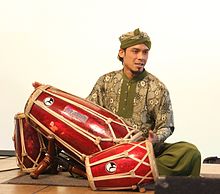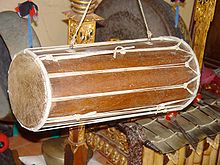Kendang

Kendang , also gendang , are barrel-shaped or cylindrical double-membrane drums made of wood, which are common in some parts of Indonesia .
The kendang plays an important role in the various types of gamelan , as it indicates the tempo, marks the beginning and end of the piece, and indicates transitions. The size and playing technique is different in the individual regions. A conical shape is typical for Bali today, an asymmetrically arched shape is used in Java , while in the music of Sumatra two standing and one lying drums are used. A smaller drum in Java is called a kolanter .
Basically, a distinction is made between two types of kendang : on the one hand with a mallet , on the other hand cacedugan (also papanggulan ; in Bali about 72 cm length, 30 cm diameter) and the one struck on both sides only with the hands (kendang ) gupek , which are slightly smaller (about 70 cm in length, 28 cm in diameter).
Design and distribution
The kendang is a double-sided tubular drum . There are always two forms of the drum on the three islands, one male and one female. From the outside, they look similar, but the difference on the inside is very considerable. Depending on whether it is a kendang wadon (female) or a kendang lanang (male), they have a different shape inside and thus a different tone resonance .
The “female” expression of the kendang wadon is hourglass-shaped and therefore has two almost separate resonance spaces, connected only by a small hole. These are of different sizes and covered with skins of different sizes. The side with the larger skin ( malu ) is male in terms of sound ( song lanang ), because it still has the smaller resonance space. The opposite side with the smaller fur ( dori ) is female ( song wadon ). The “male” drum, the kendang lanang, is almost tubular. In court music, the larger skin is usually hit with the right hand.
In Java, the large kedang gending is differentiated from the medium-sized kendang ciblon and from the small ketipung (or penuntung ). In wayang performance will be, especially when shadow play wayang kulit of rolling or earlier on the rare demonstration wayang beber , and is usually accompanied to the dance a Kendang ciblon used the clearer and higher sound than the bass drum.
The kendang is made in Bali from the wood of the breadfruit tree Artocarpus integrifolia , which can have a diameter of up to 150 centimeters at a height of up to 30 meters. Nowadays this type of tree has become relatively rare, as the demand for precious woods on the Indonesian islands has increased significantly. After felling, the wood is well seasoned and given the name ketewel . The heartwood is then freed from bark and sapwood and cut into the conical shape typical of Bali with a cleaver called timpas . Then they are scraped off with the pangot , a sickle-shaped knife, and brought into the specific male or female drum shape.
The skins ( wangkis ), which come from the Balirind sampi betina , are attached at both ends and then the outer walls are smoothed with planes. Then a kendang is ready for its musical use.
In West Java, the Kendang Pencat Ensemble, in which the bowling oboe tarompet takes over the melody, accompanies the fight dance Pencak Silat .
In Bali, the drums are traditionally kept hanging under the roof. They are then often removed in order to be used on ritual processions ( gamelan beleganjur ). To fix the drums with a hanger, two holes are drilled through which an iron wire ( juluk ) is pulled.
The tuning rings ( sumpè ) are decisive for the sound of the instruments, as far as they exist (as in Bali and Java ). The sound can be changed by simply shifting the tension of the head. However, there are no specific guidelines for tuning. Rather, the kendangs are tuned for "good sound".
In the music of Lombok , the kendang is one of the Javanese-Balinese musical instruments that the Orthodox Muslims do not play. Instead of the kendang, you use the rebana frame drum .
Another type of double-headed drum, whose heads are not tied to strings but nailed to the edge, is the bedug , which is hung in a frame or mounted on it. The bedug only occurs in the Central Javanese gamelan sekaten , but not in other gamelans ; it is used for this in popular musical styles such as the Javanese Tanjidor . In mosques, the bedug , which is also called gendang raya ("big drum"), is used to announce the time of prayer , similar to a slotted drum . Their sacred significance can be derived from the Muslim heritage of the kettle drum negara played in the sultan's courts or from the ancient Malay ritual tradition of the bronze kettle drums .
literature
- Henry Spiller: Continuity in Sundanese Dance Drumming: Clues from the 1893 Chicago Exposition. In: The World of Music. Journal of the International Institute for Traditional Music. Vol. 38 (2), 1996, pp. 23-40
- András Varsányi: Instrument making in Bali and Java . In: Andreas Lüderwaldt (Hrsg.): Contemporary Gamelan Music - 3rd International Gamelan Music Festival Bremen 2006, 25 years of Arum Sih , TenDenZen, Yearbook XIV, Überseemuseum Bremen, Rasch Verlag, Bramsche 2006, ISBN 3-89946-102-9 , Pp. 23-40.
Web links
Individual evidence
- ^ Rüdiger Schumacher: The acoustic performance of the wayang bèbèr . In: Mally Kant-Achilles, Friedrich Seltmann, Rüdiger Schumacher: Wayang Beber. The rediscovered scroll drama of Central Java. Franz Steiner, Stuttgart 1990, p. 166
- ^ Jaap Art : Music in Java. Its History, its Theory and its Technique. 3rd edition edited by Ernst L. Heins. Volume 1. Martinus Nijhoff, Den Haag 1973, pp. 214f

